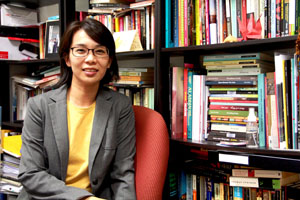Why Singapore’s English Teachers Should Embrace Singlish, Not Fight It
Is it time for Singaporean educators to embrace Singlish as a legitimate learning tool? What the Research […]
Read More
Many people see libraries as accessible, shared spaces where one can read and search for information. But how effective a space are these libraries actually? An NIE Assistant Professor decided to embark on a research journey to find out how library spaces can be effectively maximized to encourage students’ reading and learning.

Chin Ee is interested in exploring library spaces and their impact on reading.
When Assistant Professor Loh Chin Ee was conducting research in schools, she found herself waiting in school libraries in between sessions. This resulted in an interesting observation: Students were not going to the library to read.
“This then sparked my interest to begin thinking about why students use or do not use the school libraries,” Chin Ee, who is with the English Language & Literature Department at NIE, shares.
For most avid readers, the library is where they are transported into a different space with every book that they read. While the school library should be a central hub for reading, things may be a little different in reality.
Following a school-wide survey, Chin Ee concluded that the library was indeed underutilized, and this spurred her to examine why this was so and how to improve the use of libraries.
As part of her study, Chin Ee maps the space of the library to understand how social relations are shaped by the organization of space. This includes studying the layout, furniture and visuals in the library to help her understand the relationship between space, and how students are encouraged by the space towards certain kinds of behaviours and social interaction.
“For example, in one library, the tables were arranged in a large circle as the space was used as an extra classroom,” Chin Ee shares. In another instance, the placement of various comfortable armchairs and sofas around the library may encourage silent reading. Having round tables or sofa sets may also encourage collaboration and discussion.
“I also look at the kinds of displays the library has,” Chin Ee adds. “This includes posters, art and even craft materials by the students themselves.” By examining these visuals, Chin Ee hopes to understand what they communicate to students about reading and the use of the library space.
“Very often, we ask why students don’t go to the library,” Chin Ee says. “Rather than implying that students are the problem, we should look at how the library space or structure can be improved.”
Interviewing students with varying reading competency levels, Chin Ee then discovers an unusual response from them: Detention students in this school were sent to the library.
“I realized that many schools send their students to the library for detention,” she shares. “This sends out a message to these students that libraries are negative spaces.”
It is known that students get emotionally attached to different spaces within the school. In this case however, the punishment creates a “dis-attachment” to the libraries. Student feedback also further confirms that not many students visit the library, Chin Ee says.
To put it simply, there was nothing interesting enough at the library to draw them in.
“Very often, we ask why students don’t go to the library,” Chin Ee says. “Rather than implying that students are the problem, we should look at how the library space or structure can be improved.”
– Loh Chin Ee, on why students are not going to libraries
Why should students go to the library and what can we do to make that happen? These are some questions that Chin Ee asks herself during her research.
“The library could be an emotional space that provides warmth and comfort, but we also need programmes,” Chin Ee says. “The idea is to draw students into the library so they can see the relevance of the space.” This can be achieved through activities such as book selection and author talks.
Progressing further into her study, Chin Ee finds that the role of libraries is also changing in the 21st century. On top of inculcating a love of reading in students, libraries today also play a big role in teaching them information literacy and how to be critical consumers of information.
“If you think of the library as a space for teaching students critical information literacy, you will need to teach students how to select books and sort out the information they get in both books and the Internet,” Chin Ee explains.
Chin Ee hopes to work with MOE to enhance the professional development of existing school Library Coordinators who have little or no library background or training. This role is distinct from library assistants who typically manage the administrative aspects of the day-to-day operations of the library.
“Currently, our Library Coordinators are subject teachers who also have the responsibility of managing the library,” she explains. “They may have a team to help them in some schools but may lack the expertise to do book selection and train students in information literacy.”
In other countries such as the US and Australia, teacher-librarians are qualified teachers who also hold a Master’s Degree in Library Science. Their job scope includes curriculum planning and working with English and other subject teachers to plan lessons. Teacher-librarians may also suggest books and online resources that could be useful in lessons.
Therefore, Chin Ee acknowledges the importance of training Library Coordinators in Singapore schools, and providing them with the skills and tools to manage their roles well. All this goes towards maximizing the potential of school libraries so that students are drawn to visit on their own accord.
At the end of the day, it is every teacher’s wish that students see libraries as a positive space for reading and learning. As Chin Ee puts it: “Reading is important because you find out about yourself and the world, and it also stretches your thinking!”